Shuaishuai Guo
Spectral Efficiency-Aware Codebook Design for Task-Oriented Semantic Communications
Aug 06, 2025Abstract:Digital task-oriented semantic communication (ToSC) aims to transmit only task-relevant information, significantly reducing communication overhead. Existing ToSC methods typically rely on learned codebooks to encode semantic features and map them to constellation symbols. However, these codebooks are often sparsely activated, resulting in low spectral efficiency and underutilization of channel capacity. This highlights a key challenge: how to design a codebook that not only supports task-specific inference but also approaches the theoretical limits of channel capacity. To address this challenge, we construct a spectral efficiency-aware codebook design framework that explicitly incorporates the codebook activation probability into the optimization process. Beyond maximizing task performance, we introduce the Wasserstein (WS) distance as a regularization metric to minimize the gap between the learned activation distribution and the optimal channel input distribution. Furthermore, we reinterpret WS theory from a generative perspective to align with the semantic nature of ToSC. Combining the above two aspects, we propose a WS-based adaptive hybrid distribution scheme, termed WS-DC, which learns compact, task-driven and channel-aware latent representations. Experimental results demonstrate that WS-DC not only outperforms existing approaches in inference accuracy but also significantly improves codebook efficiency, offering a promising direction toward capacity-approaching semantic communication systems.
Cognitively-Inspired Emergent Communication via Knowledge Graphs for Assisting the Visually Impaired
May 28, 2025Abstract:Assistive systems for visually impaired individuals must deliver rapid, interpretable, and adaptive feedback to facilitate real-time navigation. Current approaches face a trade-off between latency and semantic richness: natural language-based systems provide detailed guidance but are too slow for dynamic scenarios, while emergent communication frameworks offer low-latency symbolic languages but lack semantic depth, limiting their utility in tactile modalities like vibration. To address these limitations, we introduce a novel framework, Cognitively-Inspired Emergent Communication via Knowledge Graphs (VAG-EC), which emulates human visual perception and cognitive mapping. Our method constructs knowledge graphs to represent objects and their relationships, incorporating attention mechanisms to prioritize task-relevant entities, thereby mirroring human selective attention. This structured approach enables the emergence of compact, interpretable, and context-sensitive symbolic languages. Extensive experiments across varying vocabulary sizes and message lengths demonstrate that VAG-EC outperforms traditional emergent communication methods in Topographic Similarity (TopSim) and Context Independence (CI). These findings underscore the potential of cognitively grounded emergent communication as a fast, adaptive, and human-aligned solution for real-time assistive technologies. Code is available at https://github.com/Anonymous-NLPcode/Anonymous_submission/tree/main.
ReCellTy: Domain-specific knowledge graph retrieval-augmented LLMs workflow for single-cell annotation
Apr 24, 2025Abstract:To enable precise and fully automated cell type annotation with large language models (LLMs), we developed a graph structured feature marker database to retrieve entities linked to differential genes for cell reconstruction. We further designed a multi task workflow to optimize the annotation process. Compared to general purpose LLMs, our method improves human evaluation scores by up to 0.21 and semantic similarity by 6.1% across 11 tissue types, while more closely aligning with the cognitive logic of manual annotation.
Unleashing the Potential of Beamspace Modulation in Near-Field MIMO: Opportunities and Challenges
Sep 29, 2024



Abstract:The principal distinction in transitioning from far-field multiple-input multiple-output (MIMO) systems to near-field MIMO configurations lies in the notable augmentation of spatial degrees of freedom (DoF). This increase is not static;rather, it dynamically fluctuates in response to user mobility. A critical challenge emerges in effectively leveraging this significantly enhanced and continuously evolving spatial DoF, particularly when constrained by a limited and energy-intensive array of radio frequency (RF) chains. This article presents an exhaustive review of the current methodologies for exploring spatial DoF in MIMO systems, with a particular emphasis on the near-field context. Central to this review is the exploration of beamspace modulation, a technique that ingeniously capitalizes on the increased and dynamic spatial DoFs inherent in near-field MIMO systems. This strategic exploitation is demonstrated to yield significant enhancements in both spectral efficiency and system reliability. Furthermore, the article delves into a detailed analysis of the multifaceted challenges associated with implementing this technology. Through this comprehensive evaluation, the work provides crucial insights into ongoing efforts to navigate these challenges and suggests potential pathways for future research in this rapidly evolving field.
Task-Oriented Communication for Graph Data: A Graph Information Bottleneck Approach
Sep 04, 2024



Abstract:Graph data, essential in fields like knowledge representation and social networks, often involves large networks with many nodes and edges. Transmitting these graphs can be highly inefficient due to their size and redundancy for specific tasks. This paper introduces a method to extract a smaller, task-focused subgraph that maintains key information while reducing communication overhead. Our approach utilizes graph neural networks (GNNs) and the graph information bottleneck (GIB) principle to create a compact, informative, and robust graph representation suitable for transmission. The challenge lies in the irregular structure of graph data, making GIB optimization complex. We address this by deriving a tractable variational upper bound for the objective function. Additionally, we propose the VQ-GIB mechanism, integrating vector quantization (VQ) to convert subgraph representations into a discrete codebook sequence, compatible with existing digital communication systems. Our experiments show that this GIB-based method significantly lowers communication costs while preserving essential task-related information. The approach demonstrates robust performance across various communication channels, suitable for both continuous and discrete systems.
The Application of Machine Learning in Tidal Evolution Simulation of Star-Planet Systems
Aug 29, 2024



Abstract:With the release of a large amount of astronomical data, an increasing number of close-in hot Jupiters have been discovered. Calculating their evolutionary curves using star-planet interaction models presents a challenge. To expedite the generation of evolutionary curves for these close-in hot Jupiter systems, we utilized tidal interaction models established on MESA to create 15,745 samples of star-planet systems and 7,500 samples of stars. Additionally, we employed a neural network (Multi-Layer Perceptron - MLP) to predict the evolutionary curves of the systems, including stellar effective temperature, radius, stellar rotation period, and planetary orbital period. The median relative errors of the predicted evolutionary curves were found to be 0.15%, 0.43%, 2.61%, and 0.57%, respectively. Furthermore, the speed at which we generate evolutionary curves exceeds that of model-generated curves by more than four orders of magnitude. We also extracted features of planetary migration states and utilized lightGBM to classify the samples into 6 categories for prediction. We found that by combining three types that undergo long-term double synchronization into one label, the classifier effectively recognized these features. Apart from systems experiencing long-term double synchronization, the median relative errors of the predicted evolutionary curves were all below 4%. Our work provides an efficient method to save significant computational resources and time with minimal loss in accuracy. This research also lays the foundation for analyzing the evolutionary characteristics of systems under different migration states, aiding in the understanding of the underlying physical mechanisms of such systems. Finally, to a large extent, our approach could replace the calculations of theoretical models.
Learning Multi-Rate Task-Oriented Communications Over Symmetric Discrete Memoryless Channels
Aug 24, 2024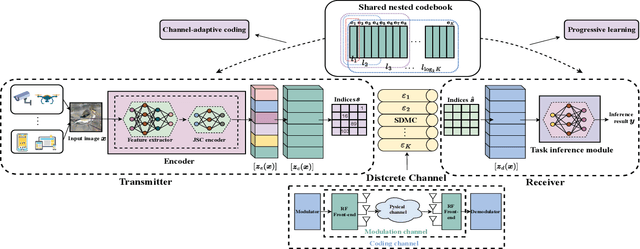

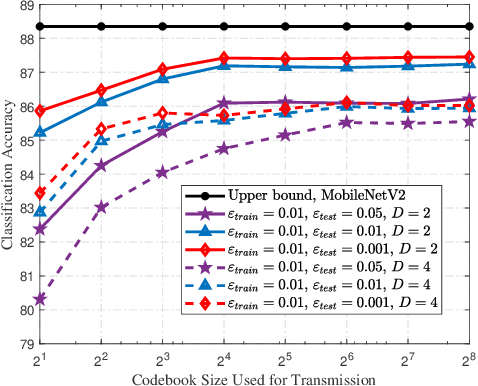
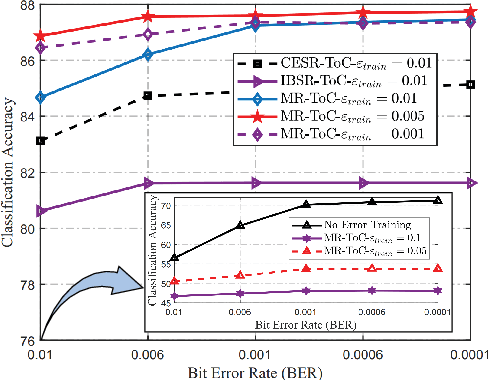
Abstract:This letter introduces a multi-rate task-oriented communication (MR-ToC) framework. This framework dynamically adapts to variations in affordable data rate within the communication pipeline. It conceptualizes communication pipelines as symmetric, discrete, memoryless channels. We employ a progressive learning strategy to train the system, comprising a nested codebook for encoding and task inference. This configuration allows for the adjustment of multiple rate levels in response to evolving channel conditions. The results from our experiments show that this system not only supports edge inference across various coding levels but also excels in adapting to variable communication environments.
Trustworthy Semantic-Enabled 6G Communication: A Task-oriented and Privacy-preserving Perspective
Aug 08, 2024

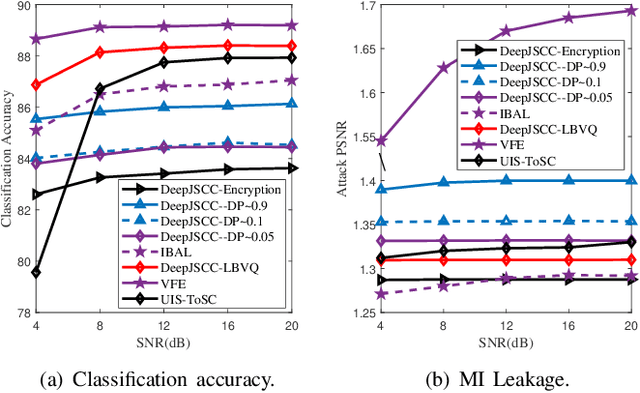
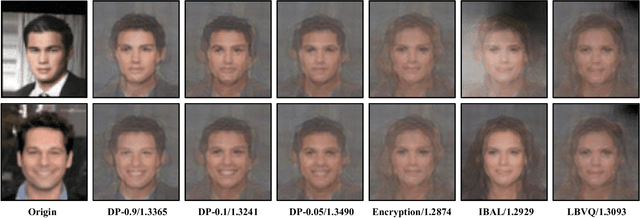
Abstract:Trustworthy task-oriented semantic communication (ToSC) emerges as an innovative approach in the 6G landscape, characterized by the transmission of only vital information that is directly pertinent to a specific task. While ToSC offers an efficient mode of communication, it concurrently raises concerns regarding privacy, as sophisticated adversaries might possess the capability to reconstruct the original data from the transmitted features. This article provides an in-depth analysis of privacy-preserving strategies specifically designed for ToSC relying on deep neural network-based joint source and channel coding (DeepJSCC). The study encompasses a detailed comparative assessment of trustworthy feature perturbation methods such as differential privacy and encryption, alongside intrinsic security incorporation approaches like adversarial learning to train the JSCC and learning-based vector quantization (LBVQ). This comparative analysis underscores the integration of advanced explainable learning algorithms into communication systems, positing a new benchmark for privacy standards in the forthcoming 6G era.
Large Language Models for Base Station Siting: Intelligent Deployment based on Prompt or Agent
Aug 07, 2024



Abstract:Traditional base station siting (BSS) methods rely heavily on drive testing and user feedback, which are laborious and require extensive expertise in communication, networking, and optimization. As large language models (LLMs) and their associated technologies advance, particularly in the realms of prompt engineering and agent engineering, network optimization will witness a revolutionary approach. This approach entails the strategic use of well-crafted prompts to infuse human experience and knowledge into these sophisticated LLMs, and the deployment of autonomous agents as a communication bridge to seamlessly connect the machine language based LLMs with human users using natural language. This integration represents the future paradigm of artificial intelligence (AI) as a service and AI for more ease. As a preliminary exploration, this research first develops a novel LLM-empowered BSS optimization framework, and heuristically proposes four different potential implementations: the strategies based on Prompt-optimized LLM (PoL), human-in-the-Loop LLM (HiLL), LLM-empowered autonomous BSS agent (LaBa), and Cooperative multiple LLM-based autonomous BSS agents (CLaBa). Through evaluation on real-world data, the experiments demonstrate that prompt-assisted LLMs and LLM-based agents can generate more efficient, cost-effective, and reliable network deployments, noticeably enhancing the efficiency of BSS optimization and reducing trivial manual participation.
Semantic Importance-Aware Communications with Semantic Correction Using Large Language Models
May 25, 2024



Abstract:Semantic communications, a promising approach for agent-human and agent-agent interactions, typically operate at a feature level, lacking true semantic understanding. This paper explores understanding-level semantic communications (ULSC), transforming visual data into human-intelligible semantic content. We employ an image caption neural network (ICNN) to derive semantic representations from visual data, expressed as natural language descriptions. These are further refined using a pre-trained large language model (LLM) for importance quantification and semantic error correction. The subsequent semantic importance-aware communications (SIAC) aim to minimize semantic loss while respecting transmission delay constraints, exemplified through adaptive modulation and coding strategies. At the receiving end, LLM-based semantic error correction is utilized. If visual data recreation is desired, a pre-trained generative artificial intelligence (AI) model can regenerate it using the corrected descriptions. We assess semantic similarities between transmitted and recovered content, demonstrating ULSC's superior ability to convey semantic understanding compared to feature-level semantic communications (FLSC). ULSC's conversion of visual data to natural language facilitates various cognitive tasks, leveraging human knowledge bases. Additionally, this method enhances privacy, as neither original data nor features are directly transmitted.
 Add to Chrome
Add to Chrome Add to Firefox
Add to Firefox Add to Edge
Add to Edge